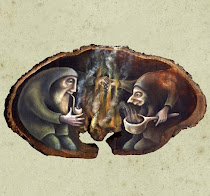BABA YAGA - famous iron-toothed witch of Russian folk tale. She lives in a house which walks about on chicken's legs and she flies in a mortar and pestle through the sky. Her garden fence is made of children's bones, and those who approach her hut in the woods must do so with all their wits and truths about them.
You may remember me painting this version of her a couple of years ago, and that I mentioned it was for a book all about Baba Yaga and her various conjurings in word and image. I am pleased to announce that the book - Baba Yaga: The Wild Witch of the East in Russian Fairy Tales - has finally been published by Mississippi University Press.
The whole thing is a lavish hardback creation with a plethora of images of Baba Yaga ranging from old lubok prints, Ivan Bilibin illustrations, old laquerwork paintings to more modern renderings familiar and new, and amongst them is my painting! There are some wonderful tales collected together here in honour of this most formidable of witches, and fascinating words of introduction by the translator of the tales Sibelan Forrester and folklorist Jack Zipes.
_____________________________
A beautifully illustrated collection of fairy tales about the most iconic and active of Russian magical characters
Baba Yaga is an ambiguous and fascinating figure. She appears in traditional Russian folktales as a monstrous and hungry cannibal or as a canny inquisitor of the adolescent hero or heroine of the tale. In new translations by Sibelan Forrester, Baba Yaga: The Wild Witch of the East in Russian Fairy Tales is a selection of tales that draws from the famous collection of Aleksandr Afanas'ev, but also includes some tales from the lesser-known nineteenth-century collection of Ivan Khudiakov. This new collection includes beloved classics such as "Vasilisa the Beautiful" and "The Frog Princess," as well as a version of the tale that is the basis for the ballet The Firebird.
The foreword and introduction place these tales in their traditional context with reference to Baba Yaga's continuing presence in today's culture--the witch appears iconically on tennis shoes, tee shirts, even tattoos. The stories are enriched with many wonderful illustrations of Baba Yaga, some old (traditional "lubok" woodcuts), some classical (the marvelous images from Victor Vasnetsov and Ivan Bilibin), and some quite recent or solicited specifically for this collection.
Sibelan Forrester, Swarthmore, Pennsylvania, is a professor of Russian at Swarthmore College and coeditor of Engendering Slavic Literatures. Helena Goscilo is a professor of Russian culture and visual culture, and is Department Chair of Slavic and East European languages and cultures at Ohio State College of Humanities, and coeditor of Politicizing Magic: An Anthology of Russian and Soviet Fairy Tales. Martin Skoro, Minneapolis, Minnesota, is a graphic designer and illustrator at MartinRoss Design.
256 pages (approx.), 8 1/2 x 11 inches, 45 color illustrations, introduction, foreword, bibliography
_____________________________
A wonderful book for lovers of Russian folktales, art and all those brave bearers of skull-lanterns through dark forests...
And if you would like a print of my painting(s) of Baba Yaga... just step this way.












































































































































